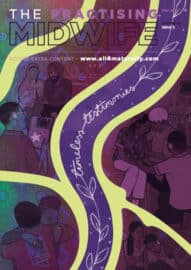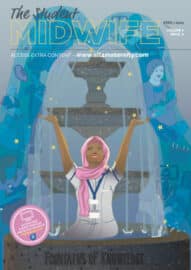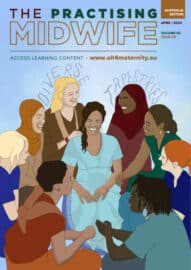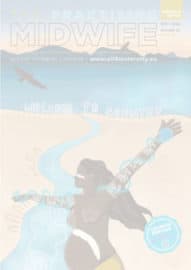Representations Of Childbirth And How They Can Affect The Choice Agenda
We live in an electronic and highly visual age where images of birth, pregnancy and motherhood saturate our social and mainstream media – however, images made by artists, which might be less available, can provide an alternative set of representations, and are rarely referenced in maternity.
Media images
What do media images say to us about childbirth? That birth is a dangerous, dramatic event; that women will scream and be out of control; that they will be delivered by a doctor or paramedic, not a midwife? This may be a caricature of media representations, however, as sited by Elson (2009) in her study ‘Mass media childbirth vs the real thing’ what we see is predominantly – ‘fear, danger, speed and pain’. We also see few images of women breastfeeding, with bottle-feeding predominating, and women who breastfeed for extended periods of time, ridiculed. In addition, motherhood is generally idealised, with women expected to be endlessly self-sacrificing and beatific, having lost any ‘baby weight’ quickly and conforming to a strictly heteronormative view of family.
The effect on women’s choices
How do these depictions affect women’s choices in childbirth? These scenarios, it is suggested by Kitzinger (2011), condition women to expect a medicalised birth and ‘submit’ to it, as ‘good obstetric patients’. They increase fear of birth (Lagan et al 2010) – which could scare women away from choices that may be seen to be outside the norm, despite there being no discernible increase in risk. Most births in the UK take place in obstetric units, and therefore anything outside of this, such as midwifery-led units or homebirth may therefore be seen to be unusual and could affect a woman’s decision to birth in these environments. They also feed into our ‘risk adverse’ society, which tends to focus on avoiding physical risks, without considering psychological or social risks. Pregnancy and childbirth have been brought into this culture which, according to Illich (1976: 267), has led to the ‘Medicalisation of all life stages – to monitor the body and control ‘deviant’ behaviour’. Therefore, as De Vries (1993: 143) argues ‘Professional groups gain control by ‘creating’ risk – that is by emphasising risk, and redefining life events as ‘risky’.
Many depictions of childbirth are also tainted by commercial interests, which can affect women’s choices, whether through the misrepresentation through advertising of breast milk substitutes as being ‘scientific formulas’, to product placement in films, publications and TV programmes, and the privatisation of healthcare. Pregnant women and new mothers have been identified as being one of the most targeted populations by advertisers.
The impact of artists’ representations
In contrast to much media and advertising depictions of childbirth, many artist representations can open up more complex understandings of the experiences and practices of childbirth and mothering – from ecstatic birth, such as Hermione Wiltshire’s 2008 portrait ‘Terez crowning in ecstatic birth’ to the mundane and brutal, such as Ana Alvarez-Errecaldo’s 2005 depiction of her daughter’s birth. Famously Mary Kelly’s documentation of her son’s first few years, ‘Postpartum document’, created during 1976-2015, included dirty nappies and recorded her guilt over going to work; and Annie Sprinkle’s 1974 concept ‘Public cervix announcement’ parodies the speculum examination, turning it into a challenging interactive performance. Depictions of breastfeeding are also complex, from the poet Hollie McNish’s powerful poem ‘Embarrassed’ (McNish 2016) – which lambasts our culture which is ‘covered in tits’ but hostile to breastfeeding in public – to artist and porn performer, Maddison Young, whose photographic image from 2011 ‘Becoming MILF’ challenges the dichotomy between motherhood and sexuality by raising the taboo of the erotic in breastfeeding. In 2004 Catherine Opie presented a depiction of breastfeeding outside the normal heteronormative frame.
The politics of choice agendas
How can we open up dialogues about different representations of childbirth and therefore encourage women to have increased autonomy and agency, and be open to choices about their experiences? Firstly, we can interrogate the issue of choice itself, often a notion hijacked by neoliberals as a weapon to demonise the disadvantaged in our society, who make the ‘wrong’ health choices and are therefore wholly responsible for their lot. We need to consider how ‘free’ women really are to make choices if those choices are either misrepresented, or they may be constrained, for a whole range of intersectional reasons. Therefore, choice in childbirth is a complex issue and should be discussed with women individually. However, through the analysis of media images of childbirth, we can expose damaging and dominant narratives, and through exploring art that depicts social and cultural realities barely represented in the mainstream media, we can present multiple readings of birth, breastfeeding and mothering that support women in the complex series of choices available to them through childbirth.
Practice recommendations
- Access artworks that present a range of images of childbirth; these can be used as a starting point to discuss that individual woman’s hopes, desires and choices.
- Inform ourselves of prevailing media narratives that tend to shut down choices and possibilities, and are heavily influenced by commercial and dominant ideologies.
- Understand the dangers of ‘choice’ when used in a political context.
- Understand the idea of ‘risk’ in a more holistic way – physical, social, cultural and psychological.
Gallery
- Ana Alvarez-Errecaldo ‘The Birth of my Daughter’ 2005
- Mary Kelly, Post-Partum Document: Documentation IV, Transitional Objects, Diary and Diagram (prototype), 1976/2015
- Catherine Opie – Self portrait nursing – 2014
- Public Cervix Announcement – Annie Sprinkle – 1974
- Hermione Wiltshire – Therese in ecstatic birth 2008 from Ina May Gaskin archive
- Madison Young ‘Becoming MILF’ 2011
References
De Vries RG (1993). ‘A cross-national view of the status of midwives’. In: Riska E and Wegar K (eds). Gender, work and medicine: women and the medical division of labour, London: Sage.
Elson V (2009). Laboring under an illusion: mass media childbirth vs the real thing (DVD), USA: Birthmedia.com
Illich I (1976) Medical nemesis – the expropriation of health, New York: Pantheon House. www.columbia.edu/itc/hs/pubhealth/rosner/g8965/client_edit/readings/week_2/illich.pdf
Kitzinger S (2011). Rediscovering birth, London: Pinter and Martin Ltd.
Lagan B, Sinclair M and Kernohan G (2010). ‘Internet use in pregnancy informs women’s decision making: a web-based survey’. Birth, 37: 134-140.
McNish H (2017). ‘Embarrassed’. In: McNish H. Nobody told me, London: Blackfriars Books.
Image credits
Ana Alvarez-Errecaldo (2005). The birth of my daughter, courtesy of the artist
Mary Kelly (1976-2015). Post-partum document: documentation IV, Transitional objects, Diary and Diagram (prototype), perspex, white card, plaster, cotton, ink, string, wood, 11 units, 35.5 x 28 cm, 14 x 11 in (each). Courtesy of the artist and Pippy Houldsworth Gallery, London.
Catherine Opie (2004). Self-portrait nursing, 2004, courtesy of the artist.
Annie Sprinkle (1974). Public cervix announcement, courtesy the artist.
Hermione Wiltshire (2008). Terez crowning in ecstatic birth, from Ina May Gaskin’s archive, courtesy of the artist.
Madison Young (2011). Becoming MILF, courtesy of the artist.













